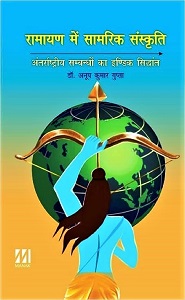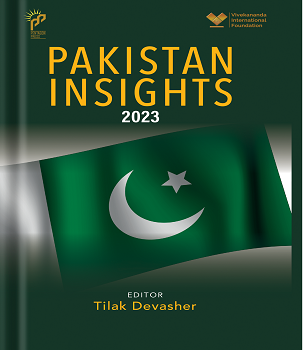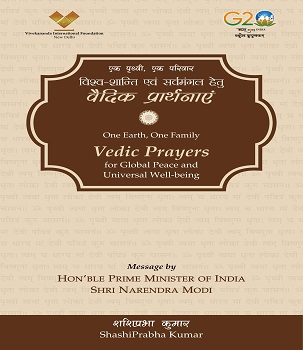The existing literature on Indian foreign policy making process has largely focussed on the formal bureaucratic structures that are responsible for policy making. The contribution of non-state actors to policy making in India hasn’t attracted much attention from scholars working on Indian foreign policy. As decision making in the arena of foreign policy and security has followed a top-down approach in India, a detailed examination of the role of think tanks in influencing the policymaking process hasn’t been undertaken so far. Stuti Bhatnagar’s India’s Pakistan Policy: How Think Tanks Are Shaping Foreign Relations is therefore a path-breaking research and a first of its kind on the role and relevance of think tanks in the policy making hierarchy of India.
She has chosen India’s relationship with Pakistan during the Composite Dialogue (CD) process that began in 2004 as a case study to investigate the influence of think tanks as well as examine their position in the policy landscape in India. The CD process lasted for almost nine years till 2013 and this period is considered by the author as ‘critical juncture’ that can have a lasting impact on the history of India-Pakistan relationship.
According to the author, unlike the case in the USA where think tanks like Chatham House and Council on Foreign Relations (CFR) get a huge amount of leeway to influence the foreign policy making process, in India there exists a lack of institutionalized linkage between the policy elite and the knowledge elite. This has resulted in a gap of literature that addresses the nexus between knowledge and power in India. The author however has attempted to fill this gap in the literature by critically examining how think tanks in India contribute to the foreign policy discourse by providing ideas that either promote or challenge the existing policy paradigms or narratives specifically with regard to Pakistan.
The author uses the Discursive Institutionalist- Gramscian framework to analyze the interactive aspects and the specific strategies that think tanks have used to have an impact and establish themselves as significant civil society actors. The DI approach emphasizes the interactive dimension of the discourse- both coordinative and communicative functions to understand the processes through which think tanks in India seek to have policy influence. As it is difficult to ascertain the causal links between actors involved in policy construction and policy change, the use of DI enables the author to enquire different levels and different types of policy ideas and how such ideas are translated into policy through the interactive processes.
Apart from undertaking an examination of the role of ideas, the author does well to incorporate the material interests of the think tanks in her study by opting for a synthesis of Discursive Instituionalist and the Gramscian framework. The Gramscian framework also allows her to investigate the pivotal role played by the intellectual elites in the think tanks of India. The knowledge elites shape the world views of the institutions and act as a bridge between the think tanks and the policy elites. It helps the author to throw light on the state-civil society relationship and underscore the role played by intellectual elites in promoting the dominant government narratives through the think tanks. In Gramscian terms, the author describes the collaboration between the intellectual and policy elites in India as the ‘historical bloc’.
Bhatnagar argues that in India there exists a symbiotic relationship between think tanks and the foreign policy bureaucracy. Whereas on one hand the think tanks may have to rely on funding from the government to sustain their research agendas, on the other hand the government also benefits from the policy inputs provided by the intellectual elites belonging to these think tanks on issues where the formal government machinery lacks expertise. The think tanks are also used to mobilize public opinion on a specific policy option taken up by the government. The think tanks contribute immensely in bringing such policies or decisions of the government into public discourse through their issue briefs, seminars, conferences and writings in media columns by the intellectual elites.
However, such collaboration and dependence on the government could circumscribe the scope of think tanks for undertaking independent research and challenge the existing paradigms of policy making. The author opts for a comparative method to illustrate her point and she categorizes the Indian think tanks into government, non-government and peace-building think tanks. The peace-building think tanks are an extension of non-government think tanks which are smaller in size and lack a sufficient resource base.
As mentioned in Chapter 4, the government think tanks like IDSA (Institute of Defence Studies and Analyses) and CLAWS (Centre for Land Warfare Studies) tend to recommend policies that are centered on national security. In other words, these tanks take their cues from the funding agencies- the MoD (Ministry of Defence) and MEA (Ministry of External Affairs). The research projects at IDSA, CLAWS, CAPS (Centre for Air Power Studies) and NMF (National Maritime Foundation) reflected the dominant discourse on Pakistan that focussed on threats from a failing Pakistani state during the Composite Dialogue process. Although strong relationship between the intellectual elites and the policymakers allowed these tanks to interact with actors at the centre of policy formation yet the evidence suggests that adoption of alternative narratives was restricted. Bhatnagar considers the knowledge elites who are retired ambassadors, bureaucrats and army officers and had worked in various government sponsored projects and committees as organic intellectuals (Gramscian concept). The primary task of such intellectuals like K. Subhramanyam, Jasjit Singh and many others was to mobilize public opinion in favour of initiatives taken by the government and the same was proved during the CD process.
Arguments in Chapter 5 show that in the case of non-government think tanks, a focus on academic research has helped to broaden the understanding of India-Pakistan relations. Differences in nature of intellectual elites and institutional agendas augmented independent academic research. But at the same time dependence on government for project funding ensured that think tanks like CPR (Centre for Policy Research) and ORF (Observer Research Foundation) maintained a balance between providing alternative research ideas and acting as forums for promoting key policy initiatives of the government. Even though the non-government think tanks had alternative sources of funding, the government played an enabling role by regulating foreign funding through legislations like the FCRA (Foreign Contribution Regulation Act).
Chapter 6 shows that the ability of peace-building think tanks like IPCS (Institute of Peace and Conflict Studies), WISCOMP (Women in Security, Conflict Management and Peace) and CDR (Centre for Dialogue and Reconciliation) to offer alternative policy narratives was more visible as they focussed on issues such as gender based violence, engagement with civil society and conflict over resources. However, as these institutes are ‘insulated agencies’ that lack government patronage, they were unable to sustain their research and drifted to adopting agendas that were not in conflict with formal bureaucracy.
The book ends with a chapter that takes into account the contemporary India-Pakistan relations under the Narendra Modi government since 2014 and the relevance of think tanks. It tells us how the CD process got derailed after the Mumbai attacks of 2008 even though the then Prime Minister Manmohan Singh tried his best in continuing the dialogue process. The author also critically analyzes the achievements of the CD process in the chapter and argues that the various initiatives of the dialogue process met with limited success due to lack of bureaucratic support and changes in the domestic polity of both India and Pakistan after 2008.
In the contemporary period the India’s relationship with Pakistan has been characterised by lack of any constructive dialogue process as Modi continues to link dialogue with the issue of state sponsored terrorism by Pakistan. According to Modi, talks with Islamabad can begin only after Pakistan is able to tackle the issue of cross-border terrorism effectively. Think tanks like VIF and IF who are said to be close to the ruling dispensation are now considered to be the premier think tanks of India with strong linkages with the ruling elite. VIF was founded in 2009 with Ajit Doval, the current National Security Advisor being one of the founding members of the institute. It has advocated for the adoption of a tough stance against Pakistan by the Indian policymakers. The Modi government has also been intimately connected with corporate funded think tanks like the ORF (funded mainly by the Reliance Foundation) that carries out public diplomacy initiatives like the Raisina Dialogue. Hence, as official dialogue process remains suspended, the stance of unofficial actors of foreign policy has also changed. Think tanks advocating for a hawkish stand against Pakistan are now more close to the government.
The author has succinctly pointed out in the book the manner in which think tanks operate in the policymaking hierarchy of India. She has argued that even though think tanks are started to being recognized as viable policy actors in India and their scope of engagement in the communicative discourse has been enhanced by the linkages between knowledge and policy elites, contribution in terms of alternative policy narratives is still missing. Factors like government funding, patronage and the ‘state spirit’ displayed by the intellectual elites have so far limited the role of think tanks in India as communicative actors. Research institutes act as a tool of propaganda for popularising government policies and also gauging public opinion. The research interests of the think tanks change with an alteration in the policies of the government as was the case after the 2008 terrorist attack in Mumbai. The way in which the author has employed the Gramscian framework to understand the role of think tanks in foreign policy is novel and praiseworthy. The book is a must read for students of international relations and scholars who are associated with research on think tanks or the processes of foreign policy making in India. The author might do well to take up a follow up research based on the same theme but focussed on India’s relationship with China.


 (1).jpg)








Good work.
Post new comment